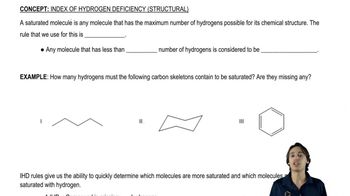Draw the structure that corresponds with each name.
e. 2,2,4,4-tetramethylhexane
f. trans-1,3-diethylcyclopentane
 Verified step by step guidance
Verified step by step guidance Verified video answer for a similar problem:
Verified video answer for a similar problem:



 1:11m
1:11mMaster How to find the root name for cycloalkanes with a bite sized video explanation from Johnny
Start learning